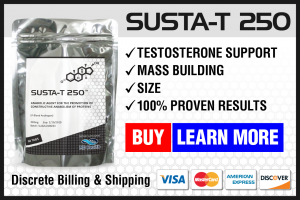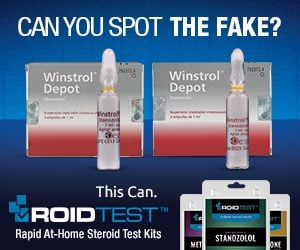Testosterone is widely considered to be the absolute safest of all anabolic steroids, and rightly so. This is because Testosterone is the number one primary anabolic steroid manufactured endogenously by the human body, and therefore it is what the human body is accustomed to the most. However, this is not to say that Testosterone comes without its share of side effects. The positive side to this is that the side effects resultants from Testosterone are very easily manageable and there exist no unknown or ‘surprise’ side effects of Testosterone. Testosterone Cypionate being an esterified variant of Testosterone obviously falls into the same pit of potential side effects.
Estrogenic Side Effects
Testosterone is very easily aromatized by the aromatase enzyme, which results in its moderate level of Estrogenic activity in the body. Testosterone Cypionate side effects hold the same obvious risk. As with the nature of all side effects, the severity of aromatization or the severity of Estrogenic side effects is directly related to the dose of Testosterone Cypionate used, and increasingly higher and higher doses used will result in a greater incidence and severity of Estrogen related side effects. It therefore goes without saying that bodybuilding doses of Testosterone (250mg per week or greater) will elicit greater amounts of aromatization as the dose is incidentally increased. One manner in which an invidiual can deal with the issue of increasing Estrogen levels is through the use of an aromatase inhibitor (such as Aromasin or Arimidex), which is an ancillary compound that serves to disable the aromatase enzyme, thereby putting a stop to rising Estrogen levels at the root cause. This would serve to eliminate water retention and any other related Estrogenic side effects. A secondary method of dealing with specific Estrogenic side effects (specifically, gynecomastia) is through the use of a SERM (Selective Estrogen Receptor Modulator) such as Nolvadex. SERMs serve to block the activity of Estrogen in breast tissue, thereby preventing its ability to initiate the growth of breast tissue (gynecomastia). It should be noted, however, that the use of a SERM does not reduce total serum Estrogen levels in the body and will therefore not eliminate water retention or any other Estrogenic side effects aside from gynecomastia. Estrogenic side effects include: water retention and bloating, blood pressure elevations (as a result of the water retention), increased possible fat retention/gain, and gynecomastia.
Androgenic Side Effects
Androgenic side effects are indeed an inclusion in the list of Testosterone Cypionate side effects. Testosterone being the human body’s primary androgenic hormone will cause androgenic side effects to become more pronounced as doses rise. Testosterone also converts into the far stronger androgen Dihydrotestosterone (DHT) by way of the 5-alpha reductase (5AR) enzyme, which is located in various tissues in the body (the prostate, scalp, and skin). It is through the conversion to DHT where the majority of more severe androgenic side effects tend to manifest. Ancillary drugs such as Proscar or Dutasteride can be utilized to effectively inhibit the 5-alpha reductase enzyme and thereby eliminate DHT at the root of its cause. This will not, however, eliminate androgenic side effects due to the fact that Testosterone itself possesses an androgenic strength rating of 100 and will still act as an androgen in various tissues throughout the body. A second option exists only for the defense against androgen-triggered male pattern baldness, which involves the topical use of Nizoral 2% shampoo. Nizoral contains the active ingredient Ketoconazole, which acts as an androgen blocker wherever it is topically applied (to the scalp, or on various areas of the skin where androgen-related acne may occur). Androgenic side effects generally include: increased sebum secretion (oily skin), increased bouts of acne (linked to increased sebum secretion), bodily and facial hair growth, and the increased risk of triggering Male Pattern Baldness (MPB) in individuals that possess the genetic trait required for the condition to manifest itself.
HPTA and Endogenous Testosterone Production Side Effects
All anabolic steroids when administered in the bodybuilding dose range required to enhance athletic performance will serve to suppress the function of the Hypothalamic Pituitary Testicular Axis (HPTA) and endogenous Testosterone production. Testosterone Cypionate side effects are no exception to this particular effect on the body’s endocrine system. As the body detects sufficient levels of exogenous Testosterone in the bloodstream, it will signal (via the negative feedback loop) a suppression and/or total shutdown of natural endogenous Testosterone production for the duration of an anabolic steroid cycle, however long it may be. It is important to note that the longer an anabolic steroid cycle continues, the more difficult it will be for the body to resume its production of endogenous Testosterone again. This is why shorter anabolic steroid cycles (in the range of 8 – 10 weeks) are preferable and longer cycles (12 weeks or more) is generally not recommended. Following the termination of any anabolic steroid cycle, it is highly advised that the user engage in a proper PCT (Post Cycle Therapy) protocol immediately, which includes the use of Testosterone production stimulating ancillary compounds, such as Nolvadex and/or HCG (Human Chorionic Gonadotropin) for a typical PCT period of 4 – 6 weeks. Failure to do so can result in permanent damage to the HPTA (Hypothalamic Pituitary Testicular Axis) whereby the individual will insufficiently produce proper levels of Testosterone for life, ultimately requiring medical intervention in the form of TRT (Testosterone Replacement Therapy).
Hepatotoxic Side Effects
Testosterone Cypionate is not a C17-alpha alkylated anabolic steroid and therefore does not exhibit any measure of toxicity on the liver. In fact, studies have investigated the potential for hepatotoxicity with Testosterone used at high doses (400mg daily, which equates to 2,800mg weekly) in several male test subjects for a 20 day period where the route of administration was actually oral instead of intramuscular injections. The idea here was to saturate the liver with high amounts of Testosterone (all orally ingested substances make what is known as a ‘first pass’ through the liver and interact with the liver at a far greater rate than the injectable route of administration). The result of the study was that no changes were observed[1]. Therefore, hepatotoxicity is not of any concern where Testosterone Cypionate side effects are concerned.
Cardiovascular Side Effects
Testosterone Cypionate side effects include the side effect of negative changes on cholesterol values as well as increasing strain on the arteries and heart – every single anabolic steroid exhibits this particular negative side effect. Oral steroids in particular are known to cause by far the worst negative impacts on cholesterol levels in the body, and are due in particular to the mechanism of action and route of administration of oral anabolic steroids, which will be covered very shortly. The negative changes of cholesterol values associated with all anabolic steroid use involves the reduction of HDL (the good cholesterol) and increases of LDL (the bad cholesterol). The result of such changes involves an increased risk of arteriosclerosis, and the degree to which these changes occur for the worse are usually dose-dependent (with higher doses increasing the negative changes and the risks). Other factors that affect these negative cholesterol changes are: duration of use, and route of administration. Testosterone itself actually happens to exhibit far less of an impact on cholesterol values in this case than all other anabolic steroids, as one of the contributing factors in this case is due to the liver’s ability to freely metabolize Testosterone, and the fact that Testosterone is not extremely resistant to hepatic breakdown and metabolism. The issue where hepatotoxicity is concerned mostly stems from certain anabolic steroids that possess the trait of exhibiting heavier resistance to hepatic metabolism than Testosterone is. This is one of the main reasons as to why oral anabolic steroids exhibit varying levels of hepatotoxicity – the C17-alpha alkylation causes the anabolic steroid to become further resistant to being metabolized or broken down by the liver. The concern as to whether an anabolic steroid has a high resistance to hepatic metabolism or a low resistance is a factor in how much impact a given anabolic steroid has on the liver’s management of cholesterol .
Testosterone in particular has demonstrated in one clinical study to have only a mild impact on HDL cholesterol after a 12 week period where 280mg of Testosterone Enanthate was administered weekly. The cholesterol profiles had later changed for the worse when an aromatase inhibitor was included, which resulted in a significant 25% drop in HDL cholesterol[2]. Conversely, other studies have been conducted whereby 300mg weekly of Testosterone Enanthate was administered for a 20 week period without the use of an aromatase inhibitor which resulted in a 13% reduction of HDL cholesterol, however, when Testosterone doses were raised to 600mg weekly, reduction of HDL cholesterol had dropped to 21%[3]. Although these studies had utilized the Enanthate ester variant of Testosterone, the conclusions and results still apply to Testosterone Cypionate considering all Testosterone preparations regardless of ester are identical in their physiological effects. Therefore, the examined data exhibits a very evident increase in Estrogen via aromatization and liver metabolism which actually helps to offset the negative cholesterol changes from the use of supraphysiological amounts of anabolic steroids. This makes sense, considering Estrogen itself is known to promote positive impacts on cholesterol levels. Therefore, the use of an aromatase inhibitor and its impact on cholesterol profiles should always be remembered when any user is considering the addition of an aromatase inhibitor on cycle. It is advisable to instead use minimal doses of an aromatase inhibitor while on a cycle for the purpose of Estrogen control rather than total Estrogen level elimination. The idea in such a case is to keep Estrogen levels within normal ranges and not allow them to skyrocket as a result of aromatization, but at the same time prevent them from dropping to near zero from the use of full doses of an aromatase inhibitor.
Testosterone Cypionate References:
[1] Enzyme induction by oral testosterone. Johnsen SG, Kampmann JP, Bennet EP, Jorgensen F. 1976 Clin Pharmacol Ther 20:233-237






